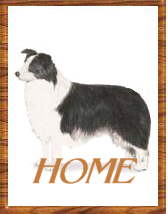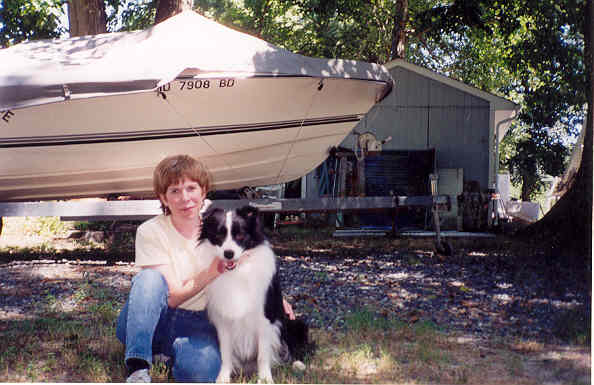Many people getting started in dogs are curious about what's involved in showing, so I would like to share a bit of my own experience.
I acquired my first AKC registered Border Collie, Liam, back in 1996. I had just lost my BC mix, Nadja, after 16-and-a-half years. Showing was the last thing on my mind - I only wanted a pet. But it wasn't long before I was bitten by "the fancy," the interest in showing dogs. Border Collies had only recently been recognized by the AKC, so it was an exciting time to get in on the action. It wasn't long before Liam hit the conformation ring.
Liam finished his conformation title fairly easily and became Ch. Darkwind's Raising Cain. Overall, it was a positive experience, but it had some frustrating moments. I was enthusiastic but also impatient. Border Collies tend to be slow to mature, both mentally and physically. Looking back, I realize that I may have started Liam before he was quite ready, so he probably wasn't as competitive as he could have been. This turned out to be a lesson in patience. Even now, I still sometimes have to remind myself to slow down when starting a young dog!
The Border Collie fancy is fortunate to have many conscientious breeders throughout the country who try to produce healthy, attractive, athletic, and sound dogs. But demand often exceeds supply, so it isn't uncommon for a prospective owner to have to wait a little while until the right pup becomes available. However, obtaining the dog is only the beginning.
Like any dog, pups bound for the show ring need socialization and training. Most breeders aim to produce dogs with outstanding temperaments, but genetics is only a part of the picture. Environment is also key. Socialization and training help to bring out the good temperament that breeders work to create. Show dogs in particular must contend with crowds, loudspeakers, strangers approaching and going over them, close proximity of other dogs, etc. Show dog education is only acquired through practice, patience, and repetition.
Show dogs also require proper exercise and nutrition to optimize their physical development. They must learn from an early age to stand quietly during regular grooming and bathing sessions. Monitoring a dog's physical condition, grooming, bathing, training, and socializing all take time out of a busy person's day. It is definitely time well spent, but other activities may have to take a back seat.
Unfortunately, even when the dog is the result of a well-planned breeding and has received excellent care from his humans, things can still go wrong. While rare, a pup may develop an unforseen problem or suffer an injury that ends all hopes of a show career. My own philosophy is that even if something does go awry, the dog can still be a "winner" as an invaluable family member. So, if you are looking for a show dog and nothing more, then I am probably not the right breeder for you.
On the other hand, if you are interested in obtaining a conformation title on your good friend and family member, I will be happy to provide all the help and support that I can. It can be a lot of fun, but keep in mind that it's also time-consuming and expensive.
Some dogs gain their championships very quickly. Others take longer, sometimes many months. You will need to decide who is going to show the dog (yourself vs. a professional handler). If you decide to handle yourself, you may need to attend handling class. Even if you don't attend class, you will need to set aside time for you and the dog to train together. If you decide on a handler, you will need to invest some time and effort into locating one who can do the job. Some handlers will accept dogs "ringside," while others insist that the dog stay with them for a period of time. Believe me, it is not always easy to have your dog away from home for extended periods of time.
On the financial end, entry fees are expensive, generally around $22 or more for each day's show. Handling fees are now upwards of $75 for each trip into the ring. This does not include what a handler may charge for grooming, transportation, and boarding (if the dog stays with him).
Campaigning Dallas into the top 3 was an incredible experience, and left me with many happy memories. A lot of people deserve thanks for their contributions. My most sincere appreciation goes to Sigrid Mortensen and Ross Mathew for breeding Dallas. Credit also goes to Robyn Powley, who brought him to the USA and gained his championship. And, of course, I thank Greg Strong of Top Of The Bay Kennels, who loves Dallas almost as much as I do. Greg did a wonderful job presenting Dallas. But the ultimate thanks goes to Dallas himself, who gave his all - and so much more!




